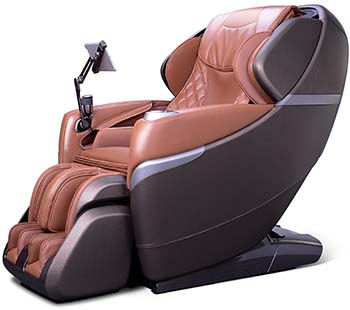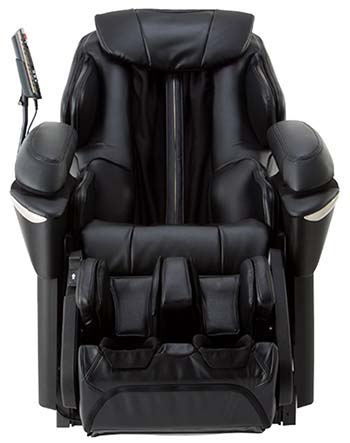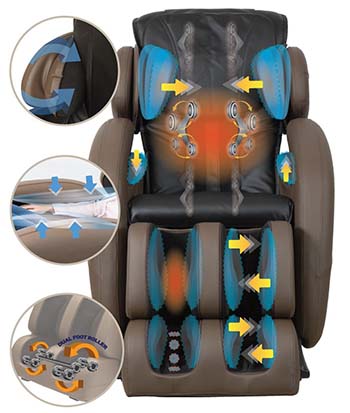There are a few key aspects to consider when deciding whether or not to invest in a massage chair over (or in addition to) human-powered massage therapy.
In this article, we’ll walk you through each of these aspects — technology, customizations, costs, time, availability, and consistency — to see how they all add up.
By the end, you’ll have a clear answer to your question… are massage chairs worth the money?
Let’s get started!
The Modern Massage Chair
Customization
Massage chairs have come a long way since their introduction in the early 50s. Once basic, not-so-custom massage chairs have evolved into true medical devices that can detect and cater to individual users.
So, how exactly does a massage chair cater to individual users?
The answer is body scanning technology.
Using technologies like optical and pressure sensors, many of today’s massage chairs scan your body before you ever begin a massage. The chairs then use that information to customize the range of the rollers so that they perfectly fit your height and shape.
One massage chair even goes as far as to “prescribe” you a massage. The chair we’re referring to here is the Cozzia Qi, which features a biometric scanning system called Chair Doctor, that diagnoses your body’s tension and then prescribes a custom-tailored massage treatment.
To learn more about the Cozzia Qi, check out our full review.
Roller Technology
So a massage chair can “read” your neck and back with body scan technology, but does the massage feel as custom as one from a massage therapist?
The short answer is no.
Massage chairs are mechanical, so they lack the level of humanness of a massage from a therapist. But rollers too have come a long way. Today, you can find massage chairs with 2D, 3D, and even 4D rollers.
Here’s how it works…
- Each roller type gives you a specific number of dimensional movements: 2D rollers move up and down and side to side, 3D rollers have the additional movement of depth, and 4D rollers include all the above plus rhythm, which alternates speeds to replicate the dynamic speeds of a human massage.
- Each roller type gives you control over a specific quality of your massage. If you like deep tissue massage or have tight knots, a 3D massage chair lets you control how deep the rollers penetrate into your muscle tissues — giving you free rein over your massage strength.
- Additionally, massage tracks have also been upgraded in recent years. Rather than only covering the neck and back, many of today’s massage chair rollers extend into the seat of the chair to treat the buttock and thighs thanks to the innovative L-Track design.
Beyond-the-Back Massage Coverage
Now you’re probably wondering… But what about the other areas of the body like the arms or feet?
That’s where air massage technology comes in.
Many of today’s massage chairs are outfitted with airbags — often from head to toe. These airbags treat the areas rollers can’t reach like the outer shoulders, sides of the thighs, arms, and hands, plus a whole bunch of other areas where they work in unison with rollers like the hips, calves, and feet.
Depending on the massage chair, the airbags either perform a compression massage which squeezes and releases an area to stimulate the muscles and increase circulation. Or, the airbags are used as part of a larger massage program, for example, a full-body stretch program.
Let’s use the Inada DreamWave massage chair as an example…
On the DreamWave, airbags next to the shoulders inflate to pin the shoulders against the backrest and to hold the upper body in place. At the same time, airbags in the ottoman inflate to hold the calves and feet in place. Then, the chair reclines and inclines at alternating levels to gently pull and stretch the muscles. And on the DreamWave, there are even airbags in the seat that swing the lower body from side to side during the stretch.
To learn more about the Inada DreamWave massage chair, check out our full review.
Massage-Enhancing Features
Another aspect of the modern massage chair is that it doesn’t just stop with massage. Many are packed with therapeutic or simply entertaining features that users love like heat therapy, Zero Gravity, chromotherapy lights, music systems, and negative ion generators.
Now that we’ve explained what you can expect from today’s massage chairs, it’s time to dig into the numbers to see how much it will really cost you.
Are Massage Chairs Worth It: The Costs
Costs Over Time
A massage chair and a massage therapist are both going to cost you, but how much can vary greatly.
Massage chairs cost anywhere from a few hundred dollars to well over $10,000. And to get a high-quality massage chair, you can expect to pay at least $2,000.
On the other hand, the average cost for a 60-minute massage from a masseuse is $60 to $120, depending on where you live and the type of massage you’re getting.
Now, let’s consider those costs over time…
Let’s say you wanted to get a high-end massage chair like the Panasonic EP-MA73. At around $8,000, if you used the chair every day for three years (Panasonic’s standard warranty), you’d be spending about $7 per day. If you purchased the extended warranty, bumping up the coverage to five years, you’d be spending a little over $4 per day.
Don’t get us wrong, Panasonic massage chairs have a long life expectancy — between 10 to 20 years. But for the sake of our example, we chose to use the warranty years to represent a “guaranteed to work” time period in which if something goes wrong it’ll get fixed without much additional cost on your end.
Now, if you and a spouse both plan on using the massage chair, you’d be spending about $3.60 per person per day for three years. Or, with the extended five year warranty, about $2 per person per day. Again, that’s only if you use the chair for five years.
In general, Chinese-made massage chairs have a life expectancy of around 10 years (but it can vary significantly between brands) and Japanese-made massage chairs have a life expectancy of around 20 years or more.
But what if you don’t want to spend $8,000 on a massage chair? How do the numbers work out for those on the budget-friendly end?
First, you should know that you can realistically expect a high-quality massage chair without the high costs. New massage chairs are introduced to the market all the time, many of them offering the same features as higher-end models. Take the $2,000 dollar Kahuna LM6800 massage chair for example. It’spacked with features like an L-Track, full body stretching, Zero Gravity, and more.
At under $2000, if you used the Kahuna LM6800 once a day for a year, you’d be spending around $5 per massage. If you used the chair once a day for three years (the warranty period), you’d be spending around $1.70 per massage. That’s one person, once a day.
Now, let’s compare the high-end numbers to massage therapy…
Let’s say the median cost for a 60-minute massage is $100 including tip. To reach the $8,000 you would spend on a high-end massage chair on massage therapy, you’d need to have two to three massages per month (or 80 total) over five years.
BUT HERE’S THE DEAL..
After five years, you’ll still be paying for it. In fact, you’ll never stop paying for it.
Think of it like this…
With massage therapy, you pay per session. With a massage chair, you pay per product.
These are totally different concepts. One requires you to pay as you go, which is good if you don’t require too much massage therapy, booking a session when you need it but perhaps not every day. And the other one requires you to pay a big fee upfront, which is good if you require lots of massages as you can save money over time.
The question then becomes… how many massages do you need?
If you have chronic pain, two or three massages per month may not be enough. On the other hand, if you have occasional flare-ups or simply want stress relief from time to time, two or three massages a year may be plenty.
To learn more about the Panasonic EP-MA73 or Kahuna LM6800 massage chairs, check out our full reviews.
Time and Availability
But not all costs are monetary. Perhaps the most valuable cost of all is time.
How long does it take to drive to the massage therapy clinic? How long does it take to book an appointment?
These are questions you should ask yourself when calculating whether a massage chair is worth it or not.
With a massage chair, your very own “mechanical masseuse” is open and available 24 hours a day, 7 days a week. You don’t have to go anywhere, squeeze time into your busy schedule, or make an appointment.
And what happens if you wake up in the middle of the night with pain? We’re not aware of any massage therapists who make middle-of-the-night house calls. But with a massage chair, you’re always a few feet away.
That said, having to “spend time” getting a massage isn’t all bad. Some people love getting out of the house to go to the spa or want the full massage experience — oils, meditation music, calming scents, soft lights. You know, the works.
Sure, massage chairs have tried to replicate these experience-enhancing elements, (music system, chromotherapy lights, etc.) but there’s no real replacement for a there-in-person spa day if that’s something you want as part of your wellness regimen.
Consistency
Another factor worth considering when trying to answer the question “is a massage chair worth it” is consistency.
Here’s the deal…
Since a massage chair is a mechanical device it can’t be anything but consistent. After all, it’s programmed to be. On the other hand, a massage therapist may or may not be consistent. This is especially true if you haven’t found your massage therapist — the person who understands your exact needs and preferences — and instead, have to see a new one each time you have a session.
The fact is, not all massage therapists perform at the same level. (To be fair, not all massage chairs perform at the same level either, which is why research is important.)
But back to consistency.
With a massage chair, you can bet that the massage you get one day will be the same massage you get the next day and for some users, that’s a compelling case for a chair.
Privacy
Lastly, a massage chair in your own home is a whole lot more private than laying on a table in an office. While this level of privacy may not matter to some, for others, like those who suffer from issues such as sciatic nerve pain, may not feel totally comfortable getting massaged by a person.
So how much privacy matters to you?
Factor that into your decision as well.
Are Massage Chairs Worth The Money? Final Thoughts
There’s one aspect of a massage therapist a chair can never replicate — human touch. But if you’re willing to overlook that aspect and focus specifically on costs, a massage chair is simply a good investment for those who need a healthy dose of massage therapy.
So, are massage chairs worth the money? We think so.





